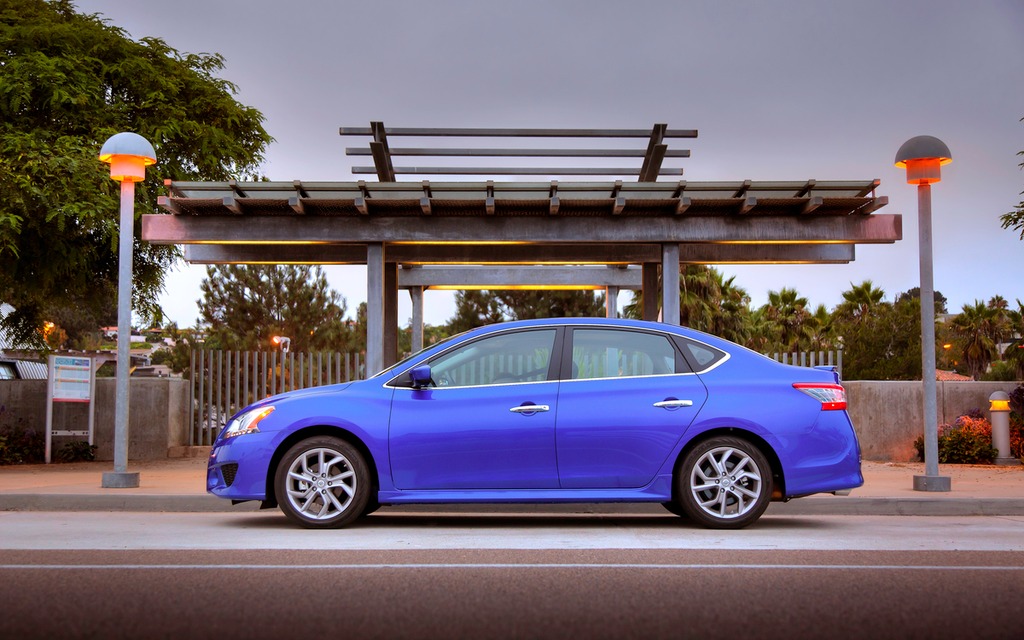2013 Nissan Sentra: A Lesson In Compromise

Something important happened in the compact car industry at the end of the last decade: automakers decided to get serious about offering high quality, low-price vehicles in the Canadian market. What this meant for drivers is that suddenly they were free to peruse options not hailing from Japan without having to sacrifice efficiency or build quality, or worry about potential reliability problems down the road.
A further implication of this compact car renaissance was that brands that had coasted for years on well-deserved reputations for producing excellent affordable cars were suddenly put on notice. Suddenly, vehicles like the Honda Civic, the Toyota Corolla, and the Nissan Sentra could no longer glide through a field of weak opponents on their way to respectable year-end sales totals as had been their birth-right.
The 2013 Nissan Sentra has been redesigned in order to shake off some of the more archaic aspects of the previous-generation car's personality and join the modern compact car battle guns blazing. Unfortunately, while the Sentra excels in some areas, it's lacking in others, and it will be up to individual buyers to decide what they are comfortable overlooking when purchasing a small sedan.
Modern Looks, Bigger Interior
One of the first things I noticed about the 2013 Nissan Sentra when I picked it up was how effectively the automaker's stylists were able to update the sedan's sheet metal without loosing too much of the Sentra's original personality. The front end of the Sentra SR is evocative of the equally-new Altima, but the grille and bold bumper works better on the smaller car than it does on its mid-size sibling. This might also be because the SV trim level I was driving was equipped with the SR package. The SR package adds an sporty body kit, front fog lights, a rear spoiler, and, on my particular tester, bright blue paint that called to mind the now-departed SE-R edition of the car. Along the sides, and around back, the revised Sentra is more mature than one might expect, helped out by the sedan's 2.3 inches of extra length and the presence of standard LED tail lights.
A longer Sentra equals a roomier Sentra, especially when factoring in the extended wheelbase offered by the 2013 model. To put it mildly, the compact car now offers an enormous back seat that will surprise almost anyone with the amount of leg and shoulder room that it makes available to those riding in the rear. The extra size of the 2013 Nissan Sentra doesn't come with a weight penalty, either, as the vehicle is now roughly 60 kilograms lighter than the version it replaces.
Simple Features And Presentation
The 2013 Nissan Sentra isn't intended to play in the premium segment, and its interior trappings are modest, yet comfortable. The console between the front seats in particular is well-integrated into the vehicle's center stack, with a carbon-look plastic trim assembly covering the seams and spiffying up the look of the vehicle's dash. Soft-touch materials on the door inserts and arm rests are also a welcome addition to the Sentra's cabin. Don't expect to be overwhelmed with features, however. NissanConnect telematics, hands-free text messaging, a navigation system, and Bluetooth can be had with the car, but aside from that the Sentra is aimed at price-conscious buyers.
Middling Performance
Nissan has also updated the Sentra's mechanical package for 2013, and this is where the sedan starts to fall down in comparison with its competitors. All versions of the Nissan Sentra have swapped the vehicle's old 2.0-liter four-cylinder engine in favour of a 1.8-liter unit that produces 10 fewer horsepower and 19 lb-ft of torque less. Total output is now rated at 130 ponies and 128 lb-ft of torque, a weakening of the Sentra's drivetrain that I could instantly feel whenever I tried to squeeze more than tepid acceleration out of the car at any given speed. The Nissan is noticeably slower than many other cars at its price point.
Another potential problem for Sentra buyers is the noisiness of its continuously-variable automatic transmission. Although a six-speed manual is also offered with the car it's a safe bet to assume that the CVT will be the gearbox of choice for the majority of buyers, and unlike other Nissan efforts in this area it's loud and buzzy when combined with the smaller four-cylinder engine. The unmuffled sound of the motor at high revs is particularly obnoxious when Sport mode is selected, as the 1.8-liter pegs itself above 5,000 rpm and stays there for what seems like an eternity as the sedan slowly builds speed.
I found myself regularly pushing the Eco button to keep the engine revs low and quiet, gladly trading acceleration for peace and quiet within the car's cabin. Who knows? Maybe this is part of an insidious scheme by Nissan engineers to help the car meet its admittedly outstanding fuel efficiency ratings of 6.6 l / 100 km city and 4.9 l / 100 km highway.
Compromise, Compromise, Compromise
The 2013 Nissan Sentra offers a ton of interior room and decent comfort at a price that starts at just under $15,000. The price for a fully-loaded Sentra does creep uncomfortably past the $25k mark, but the version of the car that I drove with the SR package can be had for in the neighbourhood of $20,000. This is an inexpensive appliance that will definitely appeal to buyers on a budget.
Unfortunately, the car's driving experience - while smooth and predictable - is an acquired taste due to the harshness of its underpowered four-cylinder engine. Nissan didn't quite get the memo that fuel economy and weak drivetrains are no longer synonyms, and the Sentra feels out of place when compared against its turbocharged, direct-injection rivals. I can't help but hope that a second engine option debuts for the Sentra in the near future to give buyers the chance to upgrade over the difficult-to-recommend base motor.









